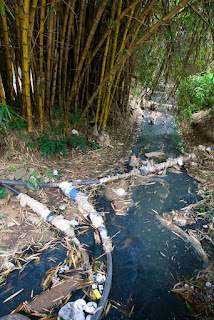I have often been asked how Indian food is like. The answer is a short one: delicious! Sure, there are things which are not advisable for European stomaches and there is also food (such as cheese, dark bread or chocolate) I definitely miss. But Indian food culture is extremely rich and has a huge variety which makes up for all.
It would be far too ambitious to give you an overview of Indian cuisine (which I don't have neither) or to tell you about all the different sorts of restaurants. This would go beyond the scope of this blog. Instead, let's have a look at a simple meal which is served in a cheap restaurant: it normally consists of rice, Indian bread (called chapathi or roti), at least two different sauces, a soupy lentil preparation (dhal), milk or yogurt based sauce, some coconut chutney and a sweet. Such meals are often served on a banana leaf and are consumed with fingers and luckily also with a spoon. And the best thing of it: the whole meal will cost around 2 or 3 Swiss Francs.
Meals at the Bühler canteen - which are complimentary - are simple but delicious and I always enjoy the short lunch breaks. Instead of a banana leaf, big stainless steel tablets are used and the atmosphere can naturally not be compared to restaurants. One of the only points I have not yet accustomed to is the South Indian breakfast which is served in the canteen. It consists for example of (too spicy) rice or semolina mashes, steamed rice cakes (iddlies), fried rice pan cakes with spicy potatoes (dosas), soups with lots of chilli, a sweet coffee etc. That is the reason why I normally take some European style breakfast at home and cut back on breakfast in the office.
So far I was very lucky not to face any severe stomach problems. Apart from a burning stomach after spicy (but tasty) dishes I am just fine and my digestive system copes well with the situation; I hope this will go on like that. Drinking tap water or using it for brushing the teeth is strictly taboo but fortunately there is a device installed in the guesthouse which incorporates a water filter and UV treatment.
As stated above there are some sorts of food which I miss, e.g. a good piece of meat from time to time. The latter is hard to find or extremely expensive and having seen butcher shops around the town I can understand that meat quality is very poor and that most Indian dishes are vegetarian (abbreviated as "veg") :-).
 |
You don't have to be a food scientist to judge the microbial quality of the meat which was shelved at about 30 °C... |
 |
And you don't have to be a animal rights activist or member of "Vier Pfoten" to despise this sort of animal housing. These small cages can be found everywhere in the town and unfortunately mostly held double the quantity of poultry.
|
When I am fed up with Indian dishes or need some change from rice, there are fortunately a handful of alternatives: cooking own dishes at the guesthouse, fast food at places such as KFC or McDonald's, Arabian restaurants serving so called Kababs, well known pizzerias such as Domino's etc.






































_edited.jpg)









